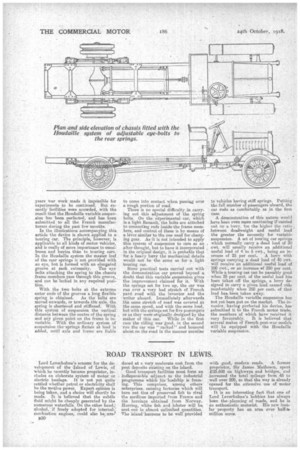- ROAD TRANSPORT IN LEWIS.
Page 10

If you've noticed an error in this article please click here to report it so we can fix it.
Lord Leverhulmes scneme for the development of the Island of Lewis, of which he recently became proprietor, includes an elaborate system of motor or electric haulage. It is not yet quite settled whether petrol or electricity shall he the motive power. Expert opinion is being taken, and a choice will shortly be made. It is believed that the subtle fluid might be cheaply generated by the numerous waterfalls. On the other hand,' alcohol, if freely adopted for internal-; combustion engines, could also bee pre-'
B30 duced at a very moderate cost from the peat deposits existing on the island.
Good transport facilities must form an indispensable adjunct to the industrial programme which hisoloedship is framing. This comprises, among others enterprises. camung factories which will turn out tins of preserved fish to rival the sardines imported -From France and the herrings obtained from Norway. Herring, white fish and lobster will be, sent out in almost unlimited quantities.. The island happens to be well provided
with good, modern roads. A former
proprietor, Sir James Matheson, spent £25,600 on highways and bridges' and increased the total mileage from 45 to well over 200, so that the way is already opened for the extensive use of motor transport.
It is an interesting fact that one of Lord Leverhulme's hobbies has always been theplanning of roads, and he is an erithuidestic motorist. His new insular property has an urea over haIf-a million acres.






















